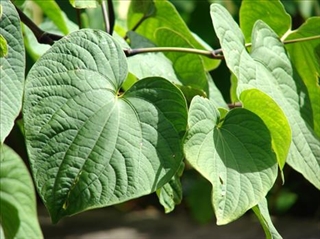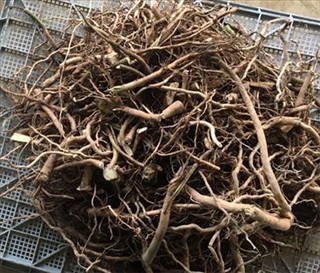 Kava (Piper methysticum) Leaves
Kava (Piper methysticum) LeavesKava-kava is a traditional beverage of the South Pacific and has centuries of use without major side effects. extracts of kava-kava produced in Western Civilizations have led to many serious health problems and even death. The extraction process is responsible for the toxicity.
Kava-kava is consumed as an intoxicating beverage typically prepared from the roots of the kava plant. Extracts are prepared from roots with water and coconut milk.
(1) Similar extracts have been consumed over the last two thousand years without serious effects on health.
(2) The intoxicating effects of the beverage have been sought by the Western world as a beneficial alternative to alcohol in reducing anxiety and as a remedy for sleeplessness and menopausal symptoms. Various commercial preparations of kava-kava, such as capsules, tinctures and fluid extracts, have been available in Europe and the USA. However, the safety of kava-kava products has been questioned due to the reported hepatotoxic side effects of kava-kava extracts.
 Kava Roots
Kava RootsThe older roots of Kava Kava are highly sought after for producing the best quality beverages. Variation of kava lactone concentrations can be expected depending on the age of the plant, the variety of the species and the harvest procedures. Root extracts of high doses of kava lactones have been reported to cause hepatotoxic side effects.
(3) Lactones are usually metabolized in the liver and in the serum.
(4)(5)
There are reported uses of stem rather than root material providing the source of kava-kava extracts in commercial production.
(6) Traditionally, if stems are used, they are peeled before preparation of the kava drink, but when demand for kava-kava from Europe and the USA was high, about twenty years ago, peelings became an important trading material as they provided a cheap, waste product with a high concentration of kava lactones for preparation as kava-kava capsules.
(6)
Pipermethysticine, an alkaloid which has been isolated from the stem peelings that is not found in the root may be responsible for the hepatotoxic side effects caused by consumption of some Western kava-kava capsules. They also commented that methods of analysis used by some companies could not distinguish between the kava lactones and pipermethysticine, so its presence was undetected.
(7)
In traditional kava-kava extracts, glutathione is extracted in a 1:1 ratio with kava lactones and these extracts have no reported side effects.
(8) The only recorded abnormality is a slightly raised activity.
(9) To avoid potential liver damage, it would therefore seem prudent to limit the organic solvent concentration in extraction.
(10)
The abuse of kava-kava has long been used as a substance of abuse as it can produce feelings of euphoria and relaxation similar to alcohol abuse. In the islands of Oceania where the fermentation of ethanol did not evolve in their cultures, kava-kava was used ceremonially and also socially as an intoxicant. In Hawaii, and more recently in other parts of the USA, "kava bars" have opened where the traditional kava-kava extracts are sold for their intoxicating properties.
Practically all psychoactive drugs are hepatotoxic.
(10) Kava lactones have a psychoactive effect and their ability to react with other medications must involve inhibition of these enzymatic pathways. If an individual with a deficiency due to overloading of the enzymatic system with other substrates were to ingest kava lactones then the result could be liver damage. This could be avoided if the kava lactones were taken with an excess of glutathione, which would pass through the stomach, where it would conjugate with kava lactones and would allow the reaction to occur. The reason that kava lactones have been linked to hepatotoxicity is due to their dependence on the cytochrome enzymes for clearance by the liver. The safe use of kava-kava has continued for many years and has been documented.
In all traditional preparations of the kava root, the kava lactones are balanced by the availability of glutathione in the preparation. In the tablet and capsule forms of extracts that relate to the reported cases of hepatotoxicity, only the kava lactones have been present in the products and no additional glutathione taken with the product. Based on the dosages reported to cause problems,
(11) the only difference is the glutathione levels which would explain the differences in toxicity.